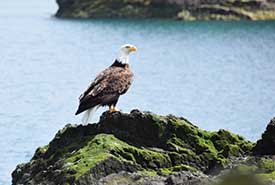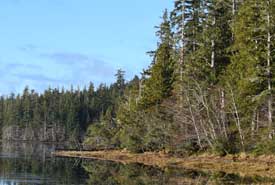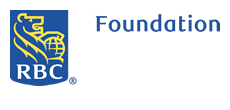Gámdas Tlagée

A bald eagle at the Kumdis estuary, Haida Gwaii, BC (Photo by NCC)
NCC is working in partnership with the Haida Nation to manage and restore a 63-hectare forest on the Kumdis Estuary on Haida Gwaii. Gámdas Tlagée holds both ecological and cultural values. In 2010, a portion of the land was illegally logged, causing significant damage to riparian areas and associated salmon habitat, cultural heritage features, wetlands and old-growth coastal temperate rainforest. As restitution for this environmentally destructive logging, the BC Provincial Court approved an option to transfer the land for conservation purposes.
In 2018, NCC and the Haida Nation entered into a partnership to co-own and co-manage the damaged area, and to hold the land in trust for future generations. The importance to local communities of the cultural heritage features and thriving fish populations on this land cannot be overstated.
“Given the cultural and ecological heritage that was lost by logging Kumdis, the prospect of restoring the area lets us imagine what it will become, once again," said kil tlaats ‘gaa Peter Lantin, president of the Haida Nation at the time. "Our partnership with the Nature Conservancy of Canada is a good way to protect and restore this very important area and in many ways is the beginning of a process to look at other areas that have been damaged as a result of the industrial-based boom-and-bust economy.
Conservation values

Gámdas Tlagée (Photo by Haida Laas-Graham Richard)
Gámdas Tlagée sustains areas of old-growth Sitka spruce and western red-cedar. A salmon-bearing stream runs through the land, emptying into the biologically rich Kumdis Estuary. The intertidal wetland areas support waterfowl, shorebirds and salmon, and extensive eelgrass beds. The salmon found in the Kumdis River and estuary represent a unique genetic repository that may be useful in replenishing stock in other river systems on Haida Gwaii that are in decline. In addition to supporting three species of salmon, this land provides habitat for the at risk marbeled murrelet (threatened) and Haida ermine (threatened).
The network of conservation lands on the Kumdis estuary includes the Kamdis Heritage Site/Conservancy (jointly managed by the Haida Nation and the Province of BC), NCC’s Kumdis River Conservation Area, conservation lands owned by The Nature Trust of BC and Ducks Unlimited Canada, and a proposed provincial Wildlife Management Area.
Despite the heavy logging on the upland portion of the conservation area, the land retains very high ecological value for its fish habitat, estuaries, wetlands and hydroriparian communities.
Everything depends on everything else
Connectivity is a word that can have many meanings. In the world of conservation, it is central to the essence of healthy, viable and biodiverse ecosystems. To Haida, this concept cascades to deeper levels of meaning, where Gina ‘waadluxan gud ad kwaagi (interconnectedness) means "everything depends on everything else." The concept of Gina ‘waadluxan gud ad kwaagi elevates the meaning of interconnectivity to include connections to the natural environment as part of both the world that surrounds us and defines that which we are made from.
Gina ‘waadluxan gud ad kwaagi is something that the Council of the Haida Nation (CHN) and NCC aim to support, strengthen and restore in the Gámdas Tlagée Conservation Area. It is a central guiding principle to next steps of management in this rich habitat.
A primary focus for achieving giid tlljuus (balance) at Gámdas Tlagée is the restoration of the many networks of streams, wetlands and smaller tributaries that form intricate networks on the landscape. A dedicated team of fish biologists from CHN and Fisheries and Oceans Canada are looking at ways to restore and re-connect these waterways. This could mean redefining stream channels, removing heavy loads of coarse woody debris or modifying stream road crossings.Together, CHN and NCC will consider many new approaches, past learnings and understandings, and respond to future developments in a manner that respects both the cultural and ecological values of the local community.
Partners in conservation
This project was made possible through the Government of Canada’s Natural Areas Conservation Program. Generous funding contributions were made by the Sitka Foundation, the Karen and Fred Green Fund (via the Vancouver Foundation), Anthony Paine and Susan Collacott, MGSP Yacht, and Geoff and Karen Cowper. The U.S. Fish and Wildlife Service (under the North American Wetlands Conservation Act) also provided funding.




